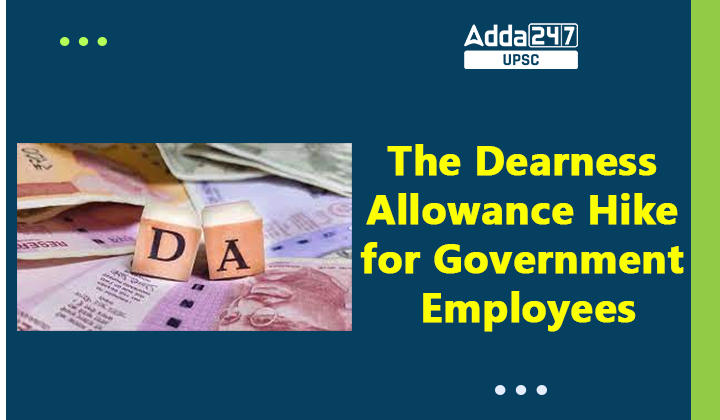Table of Contents
Government Employees Dearness Allowance: In a significant move, the Union Cabinet recently approved a 4 percentage point hike in dearness allowance (DA) and dearness relief for central government employees and pensioners, bringing it to 46 percent from the previous 42 percent. This decision, effective from July 1, comes as a timely boost for government employees and pensioners, especially during the festive season. In this article, we will delve into the implications of this DA hike, exploring its impact on the beneficiaries, the exchequer, and the broader economic landscape.
Dearness Allowance
Dearness allowance is a component of salary paid to employees and a portion of pension given to retirees to offset the impact of inflation and rising living costs. It is a dynamic allowance that changes with the cost of living index. The calculation of DA is based on the recommendations of the 7th Central Pay Commission, and revisions are made periodically to align with the prevailing economic conditions.
The Formula Behind the Hike
The dearness allowance for government employees and pensioners is estimated using the Consumer Price Index for Industrial Workers (CPI-IW), released monthly by the Labour Bureau. This index reflects changes in the prices of essential goods and services, providing a basis for adjusting DA rates. The recent hike follows the accepted formula, ensuring that it corresponds to the recommendations of the 7th Central Pay Commission.
Benefits for Government Employees and Pensioners
The primary beneficiaries of this DA hike are the 48.67 lakh central government employees and 67.95 lakh pensioners. As the cost of living continues to rise, the increase in DA becomes a crucial financial relief for these individuals. The decision to implement the hike from July 1 aims to enhance the festive season for government employees and pensioners, providing them with additional resources to meet their financial commitments.
Impact on the Exchequer
While the hike in dearness allowance brings relief to government employees and pensioners, it also imposes a financial burden on the exchequer. The total outgo for the exchequer is estimated to be Rs 12,857 crore annually. This substantial expenditure is a critical factor that policymakers need to consider, especially in the context of overall economic health and fiscal discipline.
Fiscal Responsibility and Its Challenges
The decision to increase DA raises questions about the fiscal responsibility of the government. Balancing the welfare of government employees and pensioners with the need for fiscal prudence is a delicate task. The annual outgo of over Rs 12,000 crore signifies a significant commitment from the government, and analyzing its impact on the broader economy is essential.
Economic Implications of the Hike
The increase in dearness allowance is not just a financial adjustment for individuals; it also has broader economic implications. As government employees and pensioners experience an improvement in their disposable income, there is a potential boost in consumer spending. This uptick in spending can have a cascading effect on various sectors of the economy, including retail, real estate, and services.
Inflationary Pressures and Monetary Policy
One of the concerns associated with such hikes is the potential to contribute to inflationary pressures. An increase in disposable income can lead to higher demand for goods and services, potentially driving up prices. This aspect becomes particularly relevant in the context of monetary policy, where central banks need to strike a delicate balance between supporting economic growth and maintaining price stability.
Comparative Analysis with Previous Revisions
Analyzing the frequency and magnitude of DA revisions provides insights into the government’s approach to addressing the financial concerns of employees and pensioners. The last revision, in March 2023, was a 4 percentage point increase to 42 percent. Understanding the patterns of these revisions helps in evaluating the consistency and responsiveness of the government to economic fluctuations.
Dearness Allowance Non-Productivity Linked Bonus
In addition to the DA hike, the government recently announced the grant of a non-productivity linked bonus (ad-hoc bonus) for eligible employees for the year 2022-23. This bonus, approved for Group C and non-gazetted Group B rank officials, including paramilitary forces, adds another layer to the financial support provided by the government. Analyzing the criteria for this bonus and its impact on different segments of employees offers a comprehensive view of the government’s efforts to boost morale and financial well-being.
Challenges and Criticisms
While the DA hike is generally welcomed by government employees and pensioners, it is essential to acknowledge the challenges and criticisms associated with such decisions. Some critics argue that such increases contribute to a bloated public expenditure, potentially straining the fiscal health of the government. Balancing the immediate needs of beneficiaries with long-term fiscal sustainability is a persistent challenge.
Conclusion
In conclusion, the recent dearness allowance hike for central government employees and pensioners is a nuanced decision with far-reaching implications. It signifies the government’s commitment to addressing the financial concerns of its employees during a period of economic uncertainty. However, it also raises questions about fiscal responsibility and the potential impact on inflation and overall economic stability. Striking a balance between the immediate welfare of individuals and the long-term fiscal health of the nation is a challenge that requires careful consideration and adept economic management. As we navigate through these financial landscapes, it is crucial to evaluate the multifaceted consequences of such decisions for a comprehensive understanding of their impact on individuals, the government, and the broader economy.



 TSPSC Group 1 Question Paper 2024, Downl...
TSPSC Group 1 Question Paper 2024, Downl...
 TSPSC Group 1 Answer key 2024 Out, Downl...
TSPSC Group 1 Answer key 2024 Out, Downl...
 UPSC Prelims 2024 Question Paper, Downlo...
UPSC Prelims 2024 Question Paper, Downlo...
